
Photo illustration: Sequential Turbocharging vs Parallel Turbocharging
Sequential turbocharging uses two differently sized turbochargers that operate at different engine speeds to optimize power and efficiency, enhancing performance across a wider RPM range. Parallel turbocharging employs two identical turbochargers working simultaneously, often improving boost response and power delivery in engines with multiple cylinders. Your choice between sequential and parallel turbocharging depends on your vehicle's power curve requirements and driving conditions.
Table of Comparison
| Feature | Sequential Turbocharging | Parallel Turbocharging |
|---|---|---|
| Turbo Setup | Uses two different sized turbos; small turbo at low RPM, large turbo at high RPM. | Uses two identical turbos operating simultaneously. |
| Performance | Optimizes boost pressure across entire RPM range for better throttle response and reduced turbo lag. | Improves high RPM power by sharing exhaust flow evenly between turbos. |
| Turbo Lag | Minimized at low RPM due to small turbo engagement first. | May experience moderate turbo lag as both turbos spool together. |
| Complexity | More complex design with intricate valve controls managing turbo switching. | Simpler design with parallel exhaust and intake paths. |
| Applications | Common in engines requiring wide power band and clean emissions. | Popular in V-type engines with split exhaust manifolds. |
| Cost | Higher due to complexity and control systems. | Lower cost with simpler plumbing and control. |
Introduction to Turbocharging Systems
Sequential turbocharging utilizes two differently sized turbochargers operating at varying engine speeds to optimize boost pressure and reduce turbo lag, enhancing performance across a broader RPM range. Parallel turbocharging employs two identical turbochargers working simultaneously, splitting exhaust gases to increase airflow and power output primarily for V-type engines. Both systems improve engine efficiency and power density by forcing more air into the combustion chamber compared to naturally aspirated engines.
Overview of Sequential Turbocharging
Sequential turbocharging uses multiple turbochargers of different sizes that operate at various engine speeds to optimize power and efficiency. It enables a small turbo to provide quick response at low RPM while a larger turbo kicks in at higher RPM for maximum boost. This system minimizes turbo lag and delivers a more linear power curve compared to parallel turbocharging.
Overview of Parallel Turbocharging
Parallel turbocharging uses two equally sized turbochargers operating simultaneously to provide consistent boost pressure across the engine's entire RPM range, improving efficiency and reducing turbo lag. This system is commonly applied in V-type engines, where each turbo supplies compressed air independently to one bank of cylinders. Parallel turbocharging enhances engine responsiveness and power output by maintaining balanced airflow and pressure delivery.
Key Differences Between Sequential and Parallel Turbocharging
Sequential turbocharging employs multiple turbochargers of different sizes that operate at varying engine speeds to optimize boost pressure and improve low-end torque and high-end power. Parallel turbocharging uses two or more identical turbochargers working simultaneously to split exhaust flow, enhancing efficiency and reducing turbo lag, especially in larger engines. The key difference lies in the operational strategy: sequential systems switch between turbos based on RPM, while parallel systems run all turbos continuously for more consistent boost delivery.
Performance Benefits of Sequential Turbocharging
Sequential turbocharging delivers superior engine performance by optimizing boost pressure across a wide RPM range, enhancing low-end torque while maintaining high-end power. This system employs a smaller turbocharger for low speeds and a larger one for higher RPMs, reducing turbo lag and improving throttle response. The result is improved fuel efficiency, better acceleration, and smoother power delivery compared to parallel turbocharging setups.
Performance Benefits of Parallel Turbocharging
Parallel turbocharging delivers significant performance benefits by providing more consistent boost pressure across a broad RPM range, enabling improved engine responsiveness and power output at both low and high speeds. This configuration allows two equally sized turbochargers to operate simultaneously, reducing turbo lag and enhancing airflow efficiency, which leads to better fuel combustion and increased horsepower. The balanced load sharing between the turbos minimizes heat buildup and mechanical stress, contributing to greater engine reliability and durability under demanding driving conditions.
Application Suitability: Sequential vs Parallel Turbocharging
Sequential turbocharging offers optimal performance in engines requiring broad power delivery across varied RPM ranges, making it well-suited for passenger cars and light trucks. Parallel turbocharging excels in high-performance and heavy-duty applications where maximum boost and power output at higher RPMs are crucial, commonly found in diesel engines and racing vehicles. Choosing between sequential and parallel turbocharging depends on the engine's operational requirements, desired efficiency, and driving conditions.
Efficiency and Power Delivery Comparison
Sequential turbocharging offers enhanced efficiency by using smaller and larger turbos at different engine speeds, providing optimal boost and reducing turbo lag for smooth power delivery. Parallel turbocharging, employing two identical turbos working simultaneously, delivers consistent high power output but may suffer from lower efficiency at varying RPMs. In terms of performance, sequential setups excel in fuel economy and torque across the rev range, while parallel systems prioritize maximum power at higher engine speeds.
Common Issues and Maintenance Considerations
Sequential turbocharging systems often face challenges such as turbo lag during low RPMs and complex valve actuation failures, requiring precise electronic control module diagnostics and regular actuator inspections. Parallel turbocharging setups tend to experience imbalance in turbo output and bearing wear due to synchronized operation of identical turbos, necessitating frequent oil quality checks and balancing of boost pressures. Maintenance considerations for both systems emphasize the importance of timely oil changes, intercooler cleanliness, and monitoring wastegate and bypass valve functionality to prevent performance degradation.
Choosing the Right Turbocharging System for Your Engine
Choosing the right turbocharging system depends on engine size, performance goals, and driving conditions. Sequential turbocharging optimizes power delivery across a wider RPM range by activating smaller and larger turbos at different speeds, ideal for vehicles requiring smooth acceleration and fuel efficiency. Parallel turbocharging offers simpler design and immediate boost from both turbos simultaneously, suited for high-performance applications where peak power is prioritized.
 caratoz.com
caratoz.com